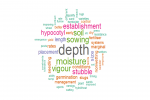GRDC Grains Research Update events provide important insights into advances in agricultural research, but also broader issues that affect the grains industry and the people within it
After a sustained period of relative stability, international markets are facing unprecedented upheaval.
Several factors could impact grain prices – US tariffs, the conflict between Russia and Ukraine, and the potential for increased self-sufficiency in importing countries.
It was to this fast-shifting trade environment that agricultural economist Dennis Voznesenski gave a keynote address at the GRDC Grains Research Update in Adelaide.
 CBA analyst Dennis Voznesenski told the GRDC Grains Research Update in Adelaide about key factors impacting grain prices in a fast-shifting trade environment. Photo: Bedford Photography
CBA analyst Dennis Voznesenski told the GRDC Grains Research Update in Adelaide about key factors impacting grain prices in a fast-shifting trade environment. Photo: Bedford Photography
A Commonwealth Bank of Australia analyst, Mr Voznesenski filters global market moves for its relevance to Australian primary production.
He was among a packed program of speakers at the two-day event, presenting on a wide range of topics affecting the Australian grains industry.
These spanned the latest in agricultural research advances to improve productivity on-farm as well as broader topics that impact farm businesses. Along with markets, these included insights on topics such as building community trust in food production, the potential for AI in agriculture and mental health.
GRDC grower relations manager Tim Bateman, who leads the Update programming team, said while seasonal issues and agronomy were front of mind, growers were also keenly interested in broader topics such as marketing and mental health.
This was illustrated by the popularity and positive responses to these sessions, which reflect the GRDC vision to grow thriving markets for future generations.
“These are issues we’re either dealing with now or potentially will face in the future, so it is great to have them on the program,” Mr Bateman said.
“Rather than only deep diving into agronomics and the practicalities of growing a crop, which are important, we’re also looking at the bigger picture of issues impacting the grains industry.”
Black Sea factor
In his presentation, Mr Voznesenski, who produces a weekly podcast on global agrimarkets, discussed key factors influencing global trade, grain prices and the Australian market.
These included tariffs, Black Sea exports from Russia and Ukraine, and the geopolitical tensions fuelling an interest in self-sufficiency.
Wheat from Russia and Ukraine had a significant impact on the market because it accounts for one in three tonnes of wheat exported, he said.
Recently, Russian wheat exports had been at record levels due to three “enormous” harvests exceeding 80 million tonnes, he said. Amid international sanctions, agricultural exports provided an opportunity to bring foreign currency into its economy.
Exports from Ukraine, while being below the historical average, had been impressive considering the conflict, he said.
These factors had worked to keep wheat prices constrained. With 80 per cent of Ukraine’s grain exported through the Odessa Port region, any disruption to that infrastructure could see prices rise.
Black Sea exports could also slow (and prices rise) if the Russian wheat yields declined. This was a realistic prospect after the crop was sown into dry conditions and received less protective snow cover than usual, he said.
Global unrest
US tariffs on Canadian imports could also affect Australia’s canola trade, Mr Voznesenski said. This was because Canada could look for alternative markets in Europe or Asia where Australia exports most of its canola.
Another longer-term impact on the Australian market could be the growing trend for governments to look at becoming more self-sufficient, he said.
After a period of sustained growth in a reliable trade environment post-World War II, the world received a wake-up call in 2020. Markets were disrupted by COVID-19 and the Russian invasion of Ukraine.
As geopolitical tensions rise and trade routes become less secure, some of the largest importers in the world, including China and Indonesia, are looking to secure food supply from within.
These countries, among others, were boosting storage capacity to buffer against temporary shocks, and/or increasing their production to reduce their reliance on imports, he said.
This scenario is problematic for the Australian grains industry, which has grown along with exports over the past eight decades. It could also produce a supply glut that would drive down prices.
But Mr Voznesenski said potential solutions could be found through increasing domestic demand, for example, through a crop-based biofuels industry.
“If we can create more domestic demand, we become less reliant on the rest of the world from a grains and oilseeds export point of view at a time when things are getting more volatile and unpredictable,” he said. “And secondly, we get a local fuel source.”
A matter of trust
GRDC Southern Panel chair and Rutherglen grain grower Andrew Russell said the GRDC Updates provided the opportunity to “look over the hill and to the horizon,” for new developments in markets and technology.
He said it was also important for growers to hear about a range of broader issues such as wellbeing and community trust in farming.
These presentations give us a reminder that we need to be keeping our families and staff fit and healthy, both physically and mentally.
Courtney Bailey, agriculture sector lead with social research company Voconiq, said in her presentation that community trust in food systems was integral to the sustainability and resilience of agricultural industries.
“We see that when trust is strong, the community is more understanding when things go wrong,” she said. Low trust, on the other hand, amplified scrutiny and resistance, potentially jeopardising operations and growth.
The grains industry, she said, was on a firm footing, with GRDC-supported Voconiq research showing there was substantial goodwill towards the grains industry in the community.
In a nationally representative survey of 3000 people, where zero is the lowest rating and five is the highest rating, it found a level of trust in the grains industry of 3.32 and acceptance at 3.6.
Ms Bailey said a score above three was positive but there was room to grow the relationship with the Australian community.
To build community trust, modelling showed it was important to be transparent, address community concerns, demonstrate environmental responsibility and use innovation to address operational challenges.
AI tools
One of those tools of innovation is AI. In his Update presentation, Dr Jonathan Richetti, a research scientist with CSIRO’s Agriculture and Food team, canvassed the potential for AI to help grow more grain.
Dr Richetti said three categories of AI systems could be useful to growers and agricultural industries:
- Classification – where a model based on remote sensing imagery can identify, for example, what crops are in the ground and what diseases or weeds are present
- Clustering – where a machine learning algorithm, for example, can split a paddock into low, medium and high-yielding zones
- Regression – which can be used, for example, to predict yield and/or generate a nitrogen fertiliser recommendation.
Understanding these three categories would help identify what type of AI application could be implemented, he said.
Because AI tools were costly, Dr Richetti recommended there be a clear strategic plan and aim for their use, along with a rich source of data to train the AI.
“AI needs data and you need a lot of observations to get outputs that make sense,” he said. “The first step is thinking about what activities have data associated with them, or public sources of data, and what can be gained from using that data via AI.”

Dr Jonathan Richetti from CSIRO told audiences at a series of GRDC Grain Research Updates how AI could help grow more grain. Photo: Melissa Marino
Power meeting
Mr Russell said hearing about a broad range of grains production issues and innovations in a group setting had a significant benefit.
The value of the GRDC Updates was not just the presentations alone, but the related conversions they sparked afterwards could help clarify the significance of the issues on your farm and your likely approach in managing these.
“Often after a presentation you’ll say to a colleague, ‘Well, what did you get out of that?’, and there’s a lot of power in hearing other perspectives. I think that’s how a lot of growers and agronomists learn – we leverage off other people’s experience and knowledge, which is great.”
Mr Bateman said the GRDC Updates – which attract hundreds of attendees each year – provided a valuable networking opportunity for all members of the grains industry.
The opportunity to discuss the ideas that are raised is really useful for researchers, advisers and growers.
“A lot of the time in farming we work remotely. We are from all parts of the state and the country, so having that central point where we can come together is really important,” he said.
Knowing who to contact when you have a question later on was also critical, and the discussions between growers and advisers enabled effective research, development, extension and adoption.
Resources:

























































